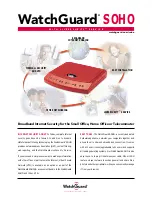
SonicWALL NSA 2400 Getting Started Guide
Page 39
Before configuring NAT Policies, you must create all Address
Objects that will be referenced by the policy. For instance, if you
are creating a One-to-One NAT policy, first create Address
Objects for your public and private IP addresses.
Address Objects are one of four object classes (Address, User,
Service and Schedule) in SonicOS Enhanced. Once you define
an Address Object, it becomes available for use wherever
applicable throughout the SonicOS management interface. For
example, consider an internal Web server with an IP address of
67.115.118.80. Rather than repeatedly typing in the IP address
when constructing Access Rules or NAT Policies, you can
create an Address Object to store the Web server’s IP address.
This Address Object, “My Web Server”, can then be used in any
configuration screen that employs Address Objects as a
defining criterion.
Since there are multiple types of network address expressions,
there are currently the following Address Objects types:
•
Host –
Host Address Objects define a single host by its IP
address.
•
Range –
Range Address Objects define a range of
contiguous IP addresses.
•
Network –
Network Address Objects are like Range
objects in that they comprise multiple hosts, but rather than
being bound by specified upper and lower range delimiters,
the boundaries are defined by a valid netmask.
•
MAC Address –
MAC Address Objects allow for the
identification of a host by its hardware address or MAC
(Media Access Control) address.
•
FQDN Address –
FQDN Address Objects allow for the
identification of a host by its Fully Qualified Domain Names
(FQDN), such as www.sonicwall.com.
SonicOS Enhanced provides a number of default Address
Objects that cannot be modified or deleted. You can use the
default Address Objects when creating a NAT policy, or you can
create custom Address Objects to use. All Address Objects are
available in the drop-down lists when creating a NAT policy.
Creating Address Objects
The
Network
>
Address Objects
page allows you to create
and manage your Address Objects. You can view Address
Objects in the following ways using the
View Style
menu:
•
All Address Objects
– displays all configured Address
Objects.
•
Custom Address Objects
– displays Address Objects
with custom properties.
•
Default Address Objects
– displays Address Objects
configured by default on the SonicWALL security
appliance.
Содержание NSA 2400
Страница 1: ...Getting Started Guide SonicWALL Network Security Appliances NETWORK SECURITY NSA 2400...
Страница 35: ...Page 34 Configuring L2 Bridge Mode...
Страница 55: ...Page 54 Deployment Configuration Reference Checklist...
Страница 63: ...Page 62 SonicWALL Secure Wireless Network Integrated Solutions Guide...
Страница 69: ...Page 68 Notes Notes...















































